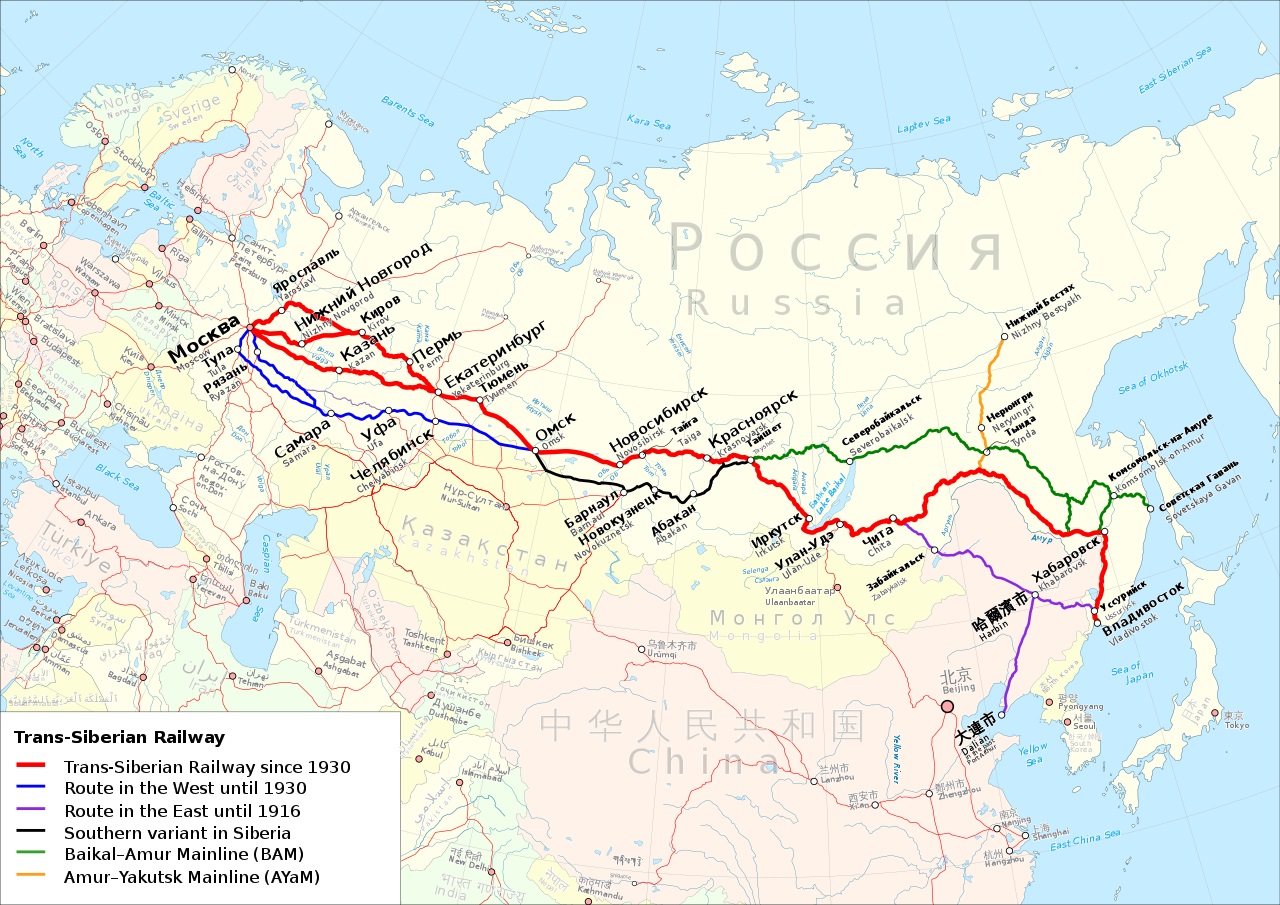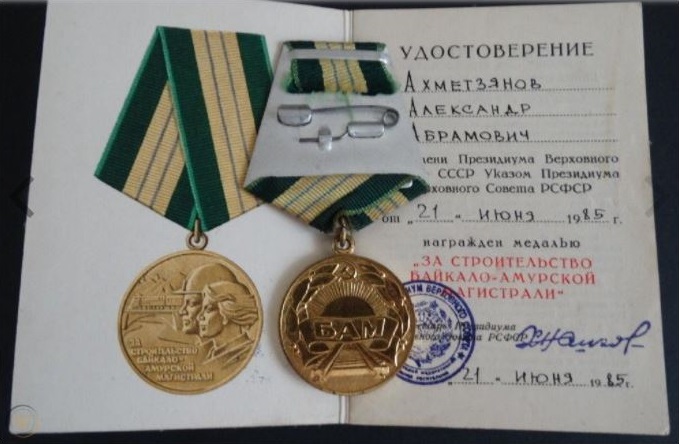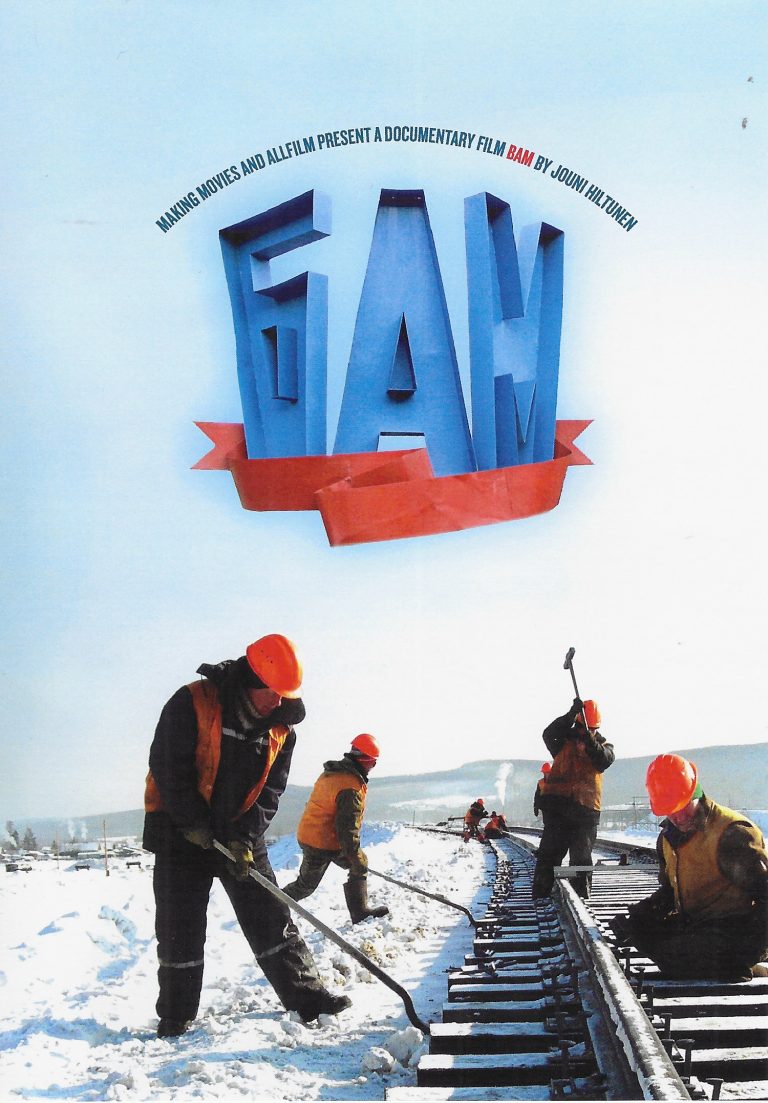 Not enough documentaries get recognition. In fact, some of them are criminally overlooked. An outrageous example is the finnish documentary "BAM" from 2008 by Jouni Hiltunen. The documentary depicts the building of the Baikal-Amur Mainline (BAM), a railroad in East Siberia and the Russian Far East. More specifically, it depicts the people who built it. This is how I stumbled over it: a late evening I was mindlessly zapping through the TV channels. My attention span was shorter than usual. Swedish Television are proud of themselves. They want to be like BBC, but have a fair way to go. Their vision is to contribute to a more inquisitive, informed Sweden and their aim is to create content that engages, entertains and enriches - in the service of the public. Well, in this case someone had fell asleep at the wheel. The documentary was broadcasted late at night and without any advance publicity. This well-produced documentary was treated like a simple TV schedule filler. And no rerun on prime time. I cannot get rid of the suspicion that it fulfilled an internal goal of number of foreign documentaries broadcasted in a year. To my knowledge, it has only been televised once (SVT2, 2008-05-04). Anyway, my viewing behaviour changed instantly. I was glued to the TV screen for one hour and eleven minutes. A Soviet documentary "The BAM Zone: Permanent Residents" (1987) seems to have been an inspiration. This Soviet documentary focus on the ghost towns left behind when the work was finished. It was made in the "Glasnost Era" when you for the first time could say that everything wasn't peaches and cream in Soviet Union. It's only 19 minutes long and contains rare footage. This documentary was directed by Mikhail Pavlov. He said: "Before filming, we screened kilometers of BAM film. There were marches and songs, meetings and delegations...But behind the screen, actually equipment was breaking down, lives were broken and souls became calloused. The track...lies there and is of no use." The finnish documentary "BAM" is a low-profile documentary about shattered dreams. It's about the search for a purpose, the need to belong and striving for a better future.
Not enough documentaries get recognition. In fact, some of them are criminally overlooked. An outrageous example is the finnish documentary "BAM" from 2008 by Jouni Hiltunen. The documentary depicts the building of the Baikal-Amur Mainline (BAM), a railroad in East Siberia and the Russian Far East. More specifically, it depicts the people who built it. This is how I stumbled over it: a late evening I was mindlessly zapping through the TV channels. My attention span was shorter than usual. Swedish Television are proud of themselves. They want to be like BBC, but have a fair way to go. Their vision is to contribute to a more inquisitive, informed Sweden and their aim is to create content that engages, entertains and enriches - in the service of the public. Well, in this case someone had fell asleep at the wheel. The documentary was broadcasted late at night and without any advance publicity. This well-produced documentary was treated like a simple TV schedule filler. And no rerun on prime time. I cannot get rid of the suspicion that it fulfilled an internal goal of number of foreign documentaries broadcasted in a year. To my knowledge, it has only been televised once (SVT2, 2008-05-04). Anyway, my viewing behaviour changed instantly. I was glued to the TV screen for one hour and eleven minutes. A Soviet documentary "The BAM Zone: Permanent Residents" (1987) seems to have been an inspiration. This Soviet documentary focus on the ghost towns left behind when the work was finished. It was made in the "Glasnost Era" when you for the first time could say that everything wasn't peaches and cream in Soviet Union. It's only 19 minutes long and contains rare footage. This documentary was directed by Mikhail Pavlov. He said: "Before filming, we screened kilometers of BAM film. There were marches and songs, meetings and delegations...But behind the screen, actually equipment was breaking down, lives were broken and souls became calloused. The track...lies there and is of no use." The finnish documentary "BAM" is a low-profile documentary about shattered dreams. It's about the search for a purpose, the need to belong and striving for a better future.
The present-day Baikal-Amur Mainline (BAM) (in green on the map) is approximately 4 300 kilometers (2 600 miles) long, more than a 1 000 kilometers of which run through permafrost areas and regions with high seismic activity. Its main branch, the Amur-Yakutsk Mainline, stretches 1 200 kilometers (746 miles). You can double-click on the map and a larger version will open in a new window. The scale of the project is gigantic. There are ten tunnels along the BAM railway. The Severomuysky Tunnel is over 15 kilometers (9 miles) and took 26 years to complete. The route crosses 11 full-flowing rivers and 7 mountain ridges. 2 230 large and small bridges were constructed. More than 60 towns and settlements, and more than 200 railway stations and railway junctions were built. BAM was intended as a strategic alternative route to the Trans-Siberian Railway (TSR), seen as vulnerable especially along the sections close to the border with China. Other goals gradually became important, like exploitation of the natural resources of Siberia and become a major conduit of trade between Europe and Asia. Another goal was to divert heavy traffic from TSR. The BAM project was very important for Soviet leadership. BAM was a demonstration of what the Soviet Union could accomplish and a projection of socialism. The idea of building a railroad across the taiga of the Far East was first proposed by the Decemberists (the real ones, not the band). The railway first came under consideration in the 1880s as an option for the eastern section of the planned TSR. The construction began in the 1930s. The first section of BAM, connecting Tynda to the Trans-Siberian Railway, was built between 1935 and 1942. During World War II, 322 kilometers (200 miles) of the track that had been laid were tore up. It was shipped west to Stalingrad, to help defend the city against the Germans. Stalin died in 1953 and the project was mothballed. The early parts were built by forced labor including the conscription of inmates of the Gulag camps and Japanese prisoners of war. However, the majority of the mainline was built between 1974 and 1984, under the authority of the Soviet industrial program focused on "mastering the North". Estimations indicate that the BAM project swallowed 1 percent of GNP during each year between 1974-1984. 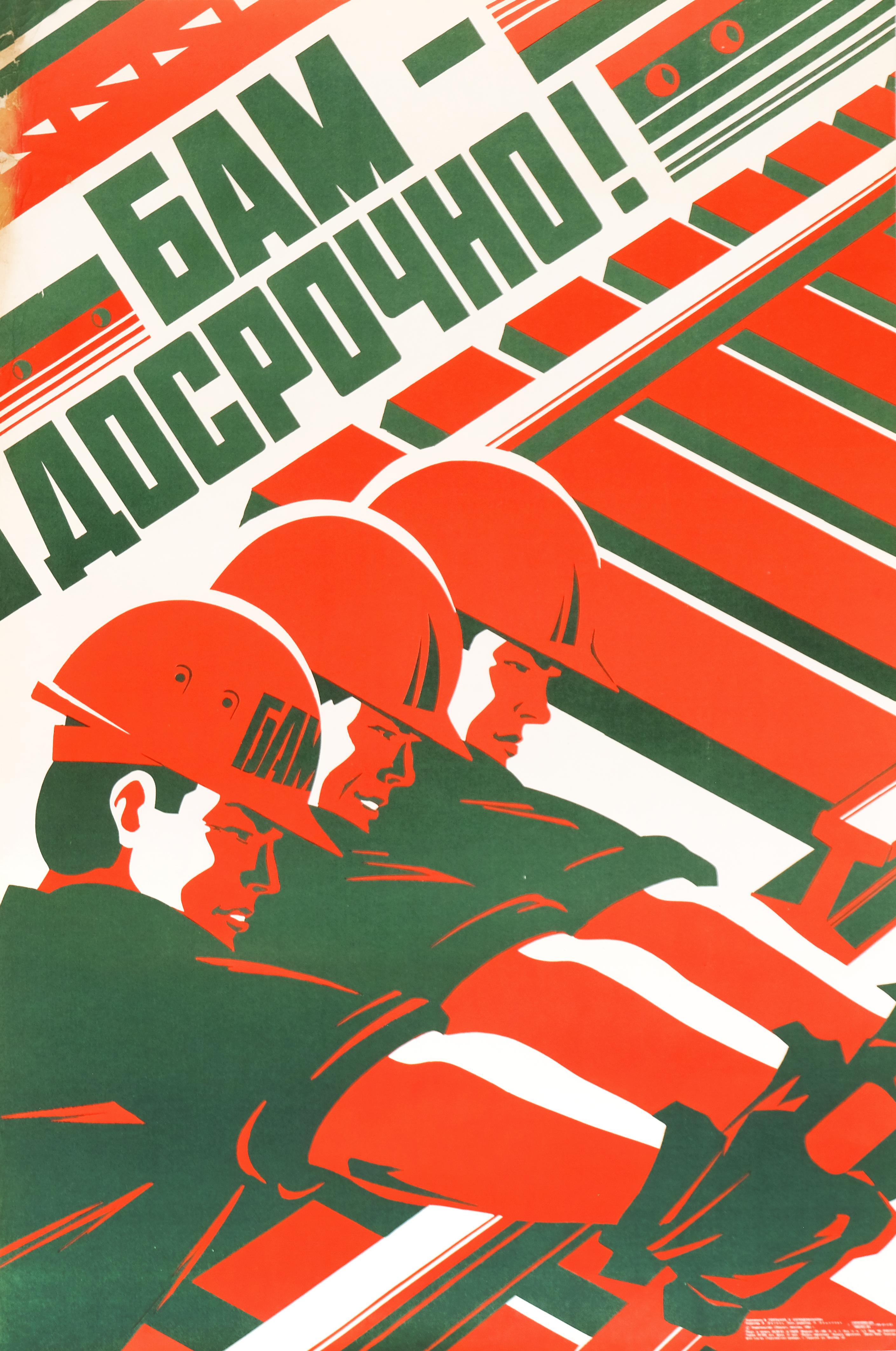 The BAM project is filled to the brim with propaganda. In March 1974, Soviet General Secretary Brezhnev proposed that the BAM would be one of the two major projects in the Tenth Five Year Plan (1976–80). In fact, it was visualized as the "Project of the Century". It was to be built with "clean hands", without forced labor. A few weeks later Brezhnev challenged the Young Communist League (Komsomol) to join in. Leonid Brezhnev addressed the 17th Komsomol Congress held in April 1974: "The Baikal-Amur Railway will transform the cities and settlements of Siberia, the North, and the Far East into high-culture centers while exploiting the rich natural resources of those regions!". The Congress declared BAM as a Komsomol shock construction project, created the central Komsomol headquarters of BAM construction, and appointed Dmitry Filippov the chief of the headquarters. The Komsomol labor mobilization campaign launched in 1974 urged young people to rally together and build the BAM in the spirit of self-sacrifice and fraternal cooperation for the sake of social strengthening in the remote corners of the Soviet Union. "First think of the motherland, and then think of yourself". There was also a material side, high salaries (triple hardship pay) and social benefits. The BAM builders also enjoyed access to goods and commodities that were regularly supplied to the region but unavailable elsewhere in the country. Allegedly, there was also promises of possibilities of buying a car after completed mission (promises that were never fulfilled). Socialist competitions occured stemming from the Stakhanovite movement (read more here, opens in an new window). Between 1974 and 1984, it's estimated that about 500 000 people worked with BAM, of which two thirds were members of Komsomol. Normally, on a three-year contract. The dark untold side of the BAM project (not depicted in the finnish documentary and often dumbed down) was mismanagement, corruption and graft, work environment problems, gender and ethnic discrimination, crime, alcoholism and sexual assault. A popular Soviet slogan at the time was "We built the BAM and the BAM built us". A good photo option came when the two legendary Komsomol brigades Bondar and Varshavsky, moving from east and west to connect, met on September 29 1984 at Balbukhta junction in the Chita Region. A "golden spike" was hammered into place, marking the opening of through traffic on the entire Baikal-Amur Railway.
The BAM project is filled to the brim with propaganda. In March 1974, Soviet General Secretary Brezhnev proposed that the BAM would be one of the two major projects in the Tenth Five Year Plan (1976–80). In fact, it was visualized as the "Project of the Century". It was to be built with "clean hands", without forced labor. A few weeks later Brezhnev challenged the Young Communist League (Komsomol) to join in. Leonid Brezhnev addressed the 17th Komsomol Congress held in April 1974: "The Baikal-Amur Railway will transform the cities and settlements of Siberia, the North, and the Far East into high-culture centers while exploiting the rich natural resources of those regions!". The Congress declared BAM as a Komsomol shock construction project, created the central Komsomol headquarters of BAM construction, and appointed Dmitry Filippov the chief of the headquarters. The Komsomol labor mobilization campaign launched in 1974 urged young people to rally together and build the BAM in the spirit of self-sacrifice and fraternal cooperation for the sake of social strengthening in the remote corners of the Soviet Union. "First think of the motherland, and then think of yourself". There was also a material side, high salaries (triple hardship pay) and social benefits. The BAM builders also enjoyed access to goods and commodities that were regularly supplied to the region but unavailable elsewhere in the country. Allegedly, there was also promises of possibilities of buying a car after completed mission (promises that were never fulfilled). Socialist competitions occured stemming from the Stakhanovite movement (read more here, opens in an new window). Between 1974 and 1984, it's estimated that about 500 000 people worked with BAM, of which two thirds were members of Komsomol. Normally, on a three-year contract. The dark untold side of the BAM project (not depicted in the finnish documentary and often dumbed down) was mismanagement, corruption and graft, work environment problems, gender and ethnic discrimination, crime, alcoholism and sexual assault. A popular Soviet slogan at the time was "We built the BAM and the BAM built us". A good photo option came when the two legendary Komsomol brigades Bondar and Varshavsky, moving from east and west to connect, met on September 29 1984 at Balbukhta junction in the Chita Region. A "golden spike" was hammered into place, marking the opening of through traffic on the entire Baikal-Amur Railway.
The "Song of the Baikal–Amur Mainline" also known as the "BAM Song" or simply "Baikal–Amur Mainline", is a Soviet propaganda song from 1975. Written by Oscar Feltsman and Robert Rozhdestvensky, the lyrics tell of the hardships the workers constructing the long railway line will endure out of a voluntary longing to serve and better their country, and of the many coming trains that will cross this new and grand railway line they toiled on. You can listen to it here.
Song Of The Baikal-Amur Mainline (BAM)
The finnish documentary depicts the people who built it, the bamovtsy (approximately BAMers in English). Read more here (opens in a new window). Many of the builders settled in the cities and towns they had built along the mainline. The end of the major construction works at the BAM overlapped with the beginning of the economic crisis and political turmoil following the collapse of the Soviet Union. In the 1990s, the infrastructure along the railroad declined: unfinished side-tracks, roads and buildings were abandoned to decay. The BAM region witnessed a large-scale out-migration of the population. Those who stayed were not happy either. Where all the hardship and sacrifice for nothing? Salaries were not paid. Unemployment increased. Promises of permanent apartment buildings or houses were not kept. Disillusion, offense and anger followed. The dissolution of the Soviet Union marked a shift in the discourse about the BAM project and its builders, from glorification to public criticism. The "path to the future" were ridiculed and became the "path to nowhere". Environment considerations were subordinate in the BAM project. Forest fires, erosion, oil and petrol spillage, inadequate purification of wastewater all damaged the environment. The sensitive Lake Baikal, the world's largest freshwater reservoir, was polluted. The negligence actually triggered the birth of the environmental movement in Soviet Union. All animals are equal, but some animals are more equal than others. The most distinguished are veterans of the BAM who came at the initial stages of the BAM construction. They differentiate themselves from late comers who arrived when the road and settlements were almost finished and launched and, thus, could enjoy better life comforts. Those who settled in the region also consider themselves to be real bamovtsy in contrast to those who left during the economic crisis of the 1990s. Soviet Union are known for three things; songs, medals and commemorations. All soaked in nostalgia. For many BAMers these years were the happiest days in their life. They are almost front-heavy with all their medals and awards. They also have very strong positive memories of solidarity, friendship and glory. Other BAMers came for the money or for the adventure. They sell their medals on Ebay to the highest bidder (yes, you can buy a medal there along with other memorabilia).
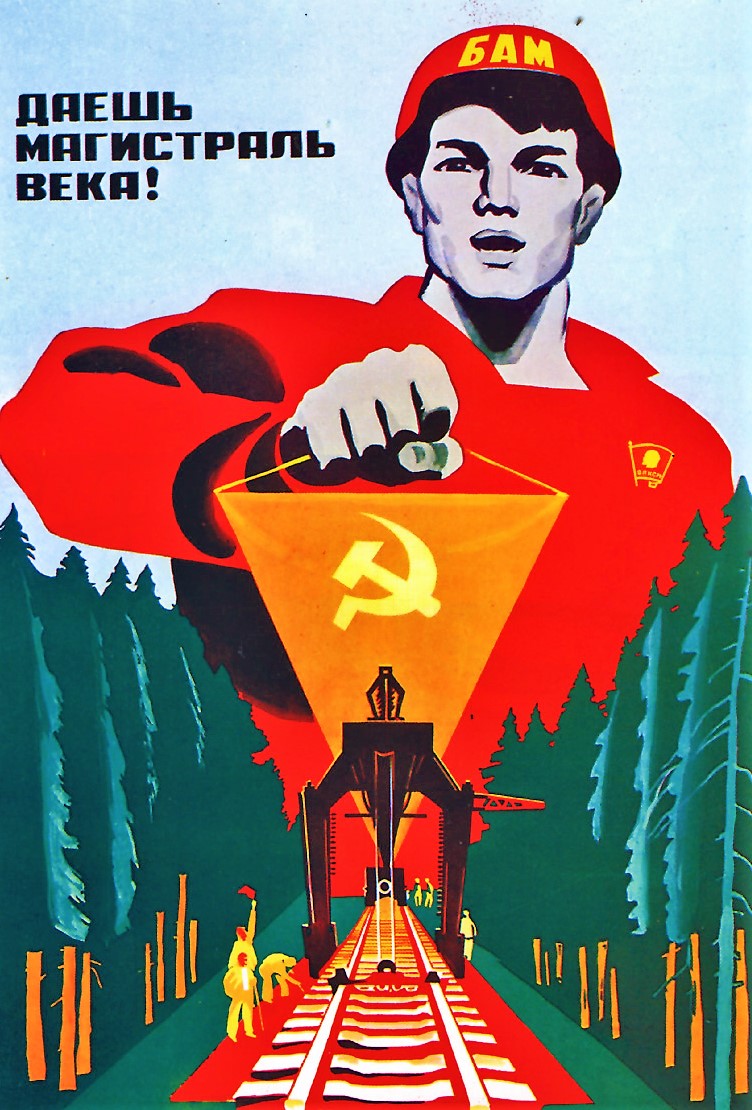 The BAM project is filled with stories and myths. The ideal type was a man (most BAMers were men) who develops himself through self-sacrifice and overcoming everyday hardships in the process of building a communist society. Young people working in extreme winter cold and in hot summers in the most inhospitable terrain imaginable, and in the absence of the most basic amenities, reading books and playing chess in their barracks and tents in the evening. But there’s another side of the story. Young idealistic workers recruited by the Komsomol were commonly dispatched to the BAM zone without no education, information or preparation. Some were adventurers or had nothing better to do, poorly trained and insufficiently motivated. BAM was split into different sites and production crews. The railway management preferred to recruit workers themselves rather than to hire workers recruited by the Komsomol. BAM was originally supposed to be built by professionals, the shortage of which was to be made up by young people. The difficulty level varied: from clearing trees to solving highly complex engineering problems. Propaganda was an integral part of the BAM project. Trips abroad (within the Soviet sphere of influence) were organized to propagandize about the project and to recruit labor. Additional workforce were needed. Workers came from Bulgaria, Cuba, Czechoslovakia, East Germany, Hungary, Mongolia, Poland, Romania and Vietnam. They were segregated from native BAMers. A lot of idealism was invested in BAM at all levels, and many participants took it very seriously. Many really believed in it, others pretended or stopped to believe. The discrepancy between the image of BAM projected in its massive propaganda campaign and the reality as experienced by those closest to it began to become clear. The life stories of the main characters developed differently. Dmitry Filippov made a brilliant career. From chief of staff of the construction of BAM to chief of staff to develop the West Siberian oil and gas industry, supervisor of the industry of Leningrad and Leningrad region, head of the State Tax Inspection, head of big and reputable financial and industrial groups and public organizations in Russia. He was killed in 1998 after being caught in a bomb explosion at the entrance to his elite apartment building. In contrast, the legendary tracklayer team leader and Hero of Socialist Labor sits in semi-darkness in his crappy apartment, smokes cheap domestic cigarettes and remembers (depicted in the documentary).
The BAM project is filled with stories and myths. The ideal type was a man (most BAMers were men) who develops himself through self-sacrifice and overcoming everyday hardships in the process of building a communist society. Young people working in extreme winter cold and in hot summers in the most inhospitable terrain imaginable, and in the absence of the most basic amenities, reading books and playing chess in their barracks and tents in the evening. But there’s another side of the story. Young idealistic workers recruited by the Komsomol were commonly dispatched to the BAM zone without no education, information or preparation. Some were adventurers or had nothing better to do, poorly trained and insufficiently motivated. BAM was split into different sites and production crews. The railway management preferred to recruit workers themselves rather than to hire workers recruited by the Komsomol. BAM was originally supposed to be built by professionals, the shortage of which was to be made up by young people. The difficulty level varied: from clearing trees to solving highly complex engineering problems. Propaganda was an integral part of the BAM project. Trips abroad (within the Soviet sphere of influence) were organized to propagandize about the project and to recruit labor. Additional workforce were needed. Workers came from Bulgaria, Cuba, Czechoslovakia, East Germany, Hungary, Mongolia, Poland, Romania and Vietnam. They were segregated from native BAMers. A lot of idealism was invested in BAM at all levels, and many participants took it very seriously. Many really believed in it, others pretended or stopped to believe. The discrepancy between the image of BAM projected in its massive propaganda campaign and the reality as experienced by those closest to it began to become clear. The life stories of the main characters developed differently. Dmitry Filippov made a brilliant career. From chief of staff of the construction of BAM to chief of staff to develop the West Siberian oil and gas industry, supervisor of the industry of Leningrad and Leningrad region, head of the State Tax Inspection, head of big and reputable financial and industrial groups and public organizations in Russia. He was killed in 1998 after being caught in a bomb explosion at the entrance to his elite apartment building. In contrast, the legendary tracklayer team leader and Hero of Socialist Labor sits in semi-darkness in his crappy apartment, smokes cheap domestic cigarettes and remembers (depicted in the documentary).
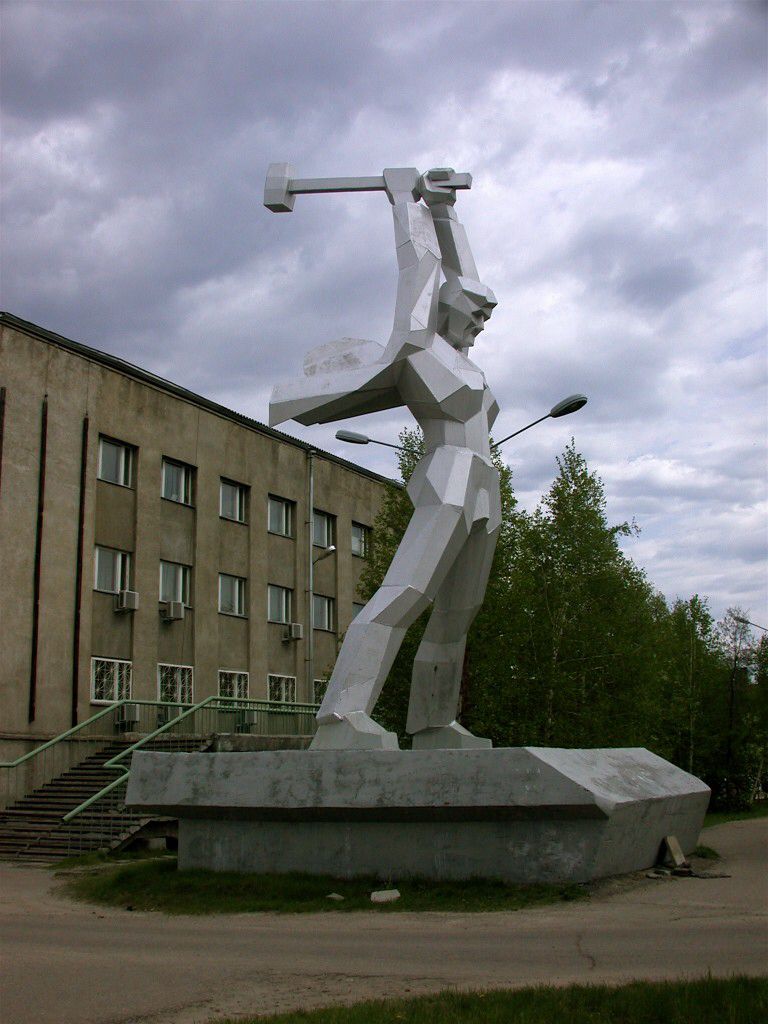 Tynda’s main attraction: the sledgehammer-wielding BAM Builders Monument. This is a spectacular example of socialist brutalism. BAM has been declared complete several times; in 1984, 1991 and 1993. President Putin finally completed the project in 2003. The total cost is disputed. BAM is underused. BAM has become a symbol of the stagnation of the Brezhnev years. Some hardcore BAMers tend to dedicate themselves to counterfactual thinking: ”if only Brezhnev would lived a couple of more years, things would be different”. The 8th July, 2014 became an important day in the history of BAM. The unofficial capital of BAM, Tynda, became the main venue of festivities marking the 40th anniversary of the start of the construction of Baikal–Amur Mainline (BAM). President Vladimir Putin held a videoconference to congratulate veteran-builders and railway workers. "We intend to invest in the mainline’s expansion and, in my view, this should inspire our veterans, should demonstrate that their efforts were not wasted, that they have implemented a project that is of great importance for the country, a project that will be carried on." The event was attended by a number of prominient guests, veterans, journalists and pop stars(!). The opening started with an awards ceremony (yes, songs, medals and commerations). During the official celebrations, about a dozen BAM veterans living near Tynda went on a hunger strike while others picketed a train carrying official guests, demanding the resettlement of workers in the mainland, or European Russia. What about BAM's future? Commodity prices decides if, and when, resources are profitable. With pricing booms BAM has regained a new interest and sparked a plan to modernise the railway. After the modernisation, the number of freight trains will increase allowing the transport of more cargo. The cost of a large-scale upgrade is enormous. Climate change could cause huge problems. About one fourth of BAM runs on permafrost. If the permafrost layer that supports the BAM railway line were to melt, the railway would collapse and sink into peat bog layers that cannot bear its weight. There are reports about climate change and damage to buildings and infrastructure as a result of thawing permafrost. So far, the result of the modernisation project isn’t encouraging. The year of 2024 will mark the 50th anniversary of the start of the construction of Baikal–Amur Mainline. We will just have to wait and see. Why am I so interested of BAM? It has one thing in common with the gothic country genre - shattered dreams.
Tynda’s main attraction: the sledgehammer-wielding BAM Builders Monument. This is a spectacular example of socialist brutalism. BAM has been declared complete several times; in 1984, 1991 and 1993. President Putin finally completed the project in 2003. The total cost is disputed. BAM is underused. BAM has become a symbol of the stagnation of the Brezhnev years. Some hardcore BAMers tend to dedicate themselves to counterfactual thinking: ”if only Brezhnev would lived a couple of more years, things would be different”. The 8th July, 2014 became an important day in the history of BAM. The unofficial capital of BAM, Tynda, became the main venue of festivities marking the 40th anniversary of the start of the construction of Baikal–Amur Mainline (BAM). President Vladimir Putin held a videoconference to congratulate veteran-builders and railway workers. "We intend to invest in the mainline’s expansion and, in my view, this should inspire our veterans, should demonstrate that their efforts were not wasted, that they have implemented a project that is of great importance for the country, a project that will be carried on." The event was attended by a number of prominient guests, veterans, journalists and pop stars(!). The opening started with an awards ceremony (yes, songs, medals and commerations). During the official celebrations, about a dozen BAM veterans living near Tynda went on a hunger strike while others picketed a train carrying official guests, demanding the resettlement of workers in the mainland, or European Russia. What about BAM's future? Commodity prices decides if, and when, resources are profitable. With pricing booms BAM has regained a new interest and sparked a plan to modernise the railway. After the modernisation, the number of freight trains will increase allowing the transport of more cargo. The cost of a large-scale upgrade is enormous. Climate change could cause huge problems. About one fourth of BAM runs on permafrost. If the permafrost layer that supports the BAM railway line were to melt, the railway would collapse and sink into peat bog layers that cannot bear its weight. There are reports about climate change and damage to buildings and infrastructure as a result of thawing permafrost. So far, the result of the modernisation project isn’t encouraging. The year of 2024 will mark the 50th anniversary of the start of the construction of Baikal–Amur Mainline. We will just have to wait and see. Why am I so interested of BAM? It has one thing in common with the gothic country genre - shattered dreams.

